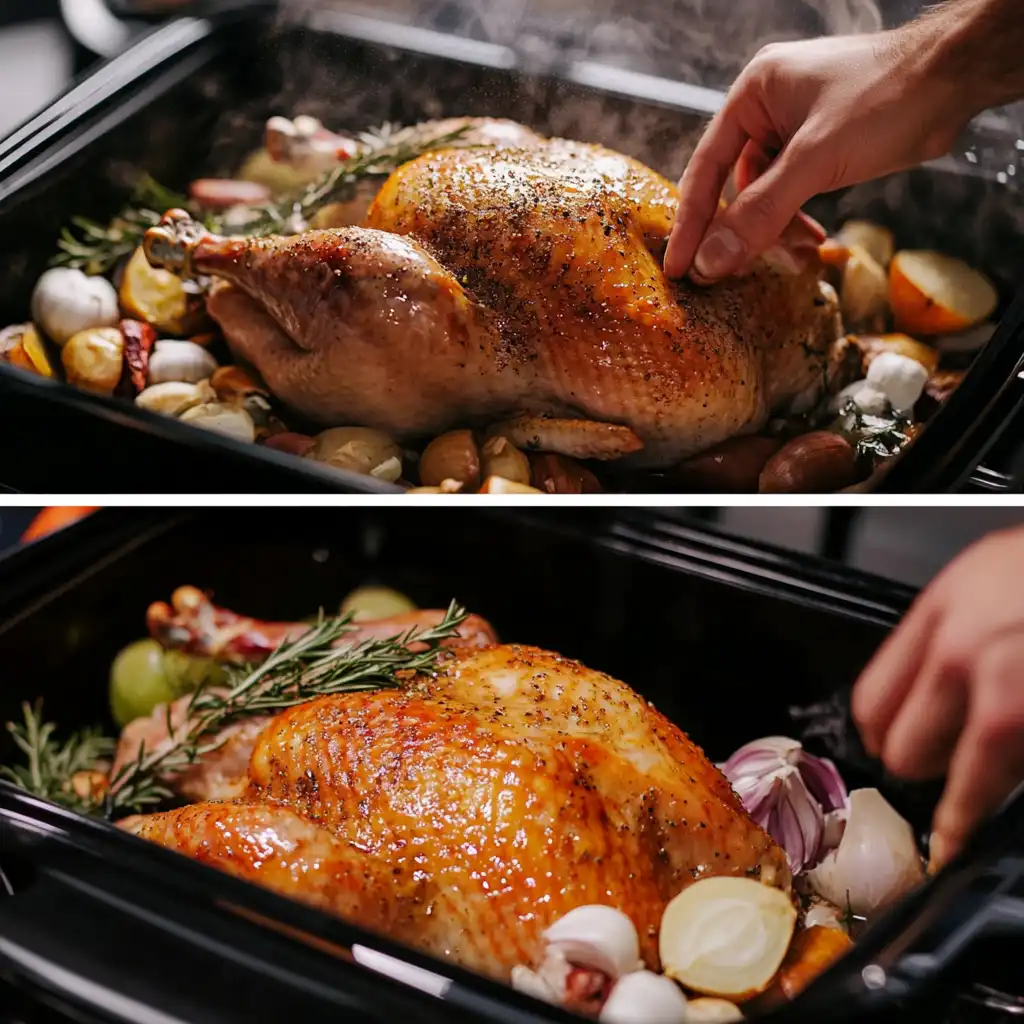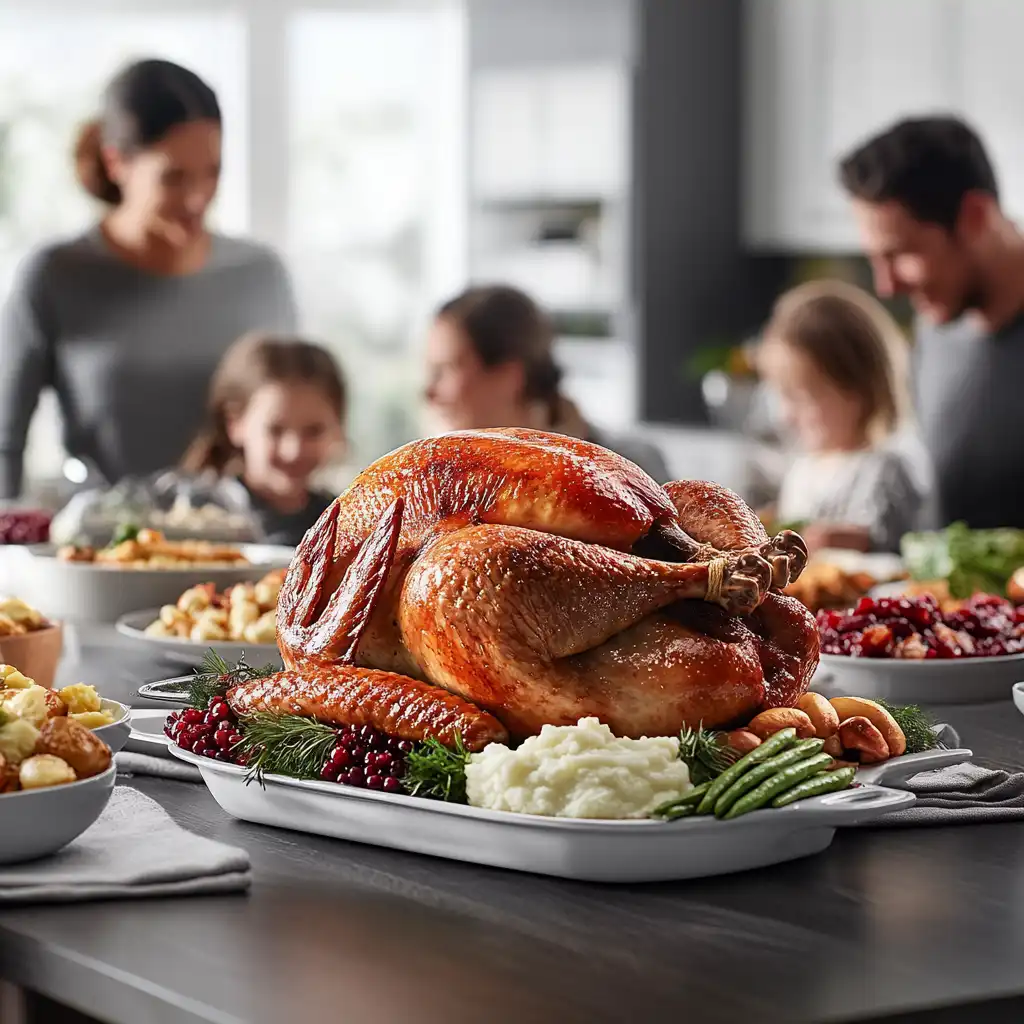The Ultimate Guide to Turkey Roasters: Tips, Reviews & More
Roasting the perfect turkey is no longer a challenge when you’ve got the right turkey roaster by your side. Whether you’re hosting a grand holiday feast or preparing a cozy family dinner, a turkey roaster simplifies the process, delivering juicy, evenly cooked results every time. In this comprehensive guide, we’ll explore everything you need to know about turkey roasters—from choosing the best one to maximizing its potential in your kitchen. Let’s dive into Part 1!
Part 1: Introduction to Turkey Roasters
What Is a Turkey Roaster?
A turkey roaster is a specialized kitchen appliance or cookware designed to cook large cuts of meat—especially turkeys—with precision and ease. Unlike traditional roasting pans, these roasters come in various types, including electric turkey roasters, stovetop options, and classic oven-safe models. They offer better heat distribution, energy efficiency, and often come with handy features like removable racks and temperature controls.

Why You Need a Turkey Roaster in Your Kitchen
Imagine this: It’s Thanksgiving, and your oven is crammed with casseroles, pies, and stuffing. Where does the turkey go? That’s where a turkey roaster shines. Not only does it free up your oven space, but it also ensures that your turkey cooks evenly and stays juicy. Moreover, many models are portable, making them perfect for gatherings or events where oven access might be limited.
Benefits of Using a Turkey Roaster:
- Consistent Cooking Results: Thanks to even heat distribution, your turkey cooks perfectly inside and out.
- Space Saving: Frees up your oven for other dishes.
- Energy Efficient: Electric models are more efficient than heating an entire oven.
- Versatility: You can cook more than turkey—think roasts, casseroles, and even desserts.
Types of Turkey Roasters
Choosing the right turkey roaster starts with knowing the options available:
- Electric Turkey Roasters: These plug-in appliances are convenient and easy to use, with features like automatic timers and temperature controls.
- Stovetop Turkey Roasters: These versatile roasters double as cookware, perfect for those who want multi-purpose tools.
- Traditional Oven-Safe Roasters: Classic roasting pans designed for use in the oven, often made from stainless steel or aluminum for durability.
Part 2: Features to Look for in a Turkey Roaster
How to Choose the Best Turkey Roaster for Your Needs
Picking the perfect turkey roaster can feel a bit overwhelming, especially with so many options out there. But don’t worry—we’ve got your back! When choosing the right one, consider its size, material, features, and ease of maintenance. Let’s break it down so you can make an informed decision.
Size and Capacity
When it comes to size, think about how many people you typically cook for. A large turkey roaster is great for gatherings, but a smaller one may suffice for intimate family dinners. Most models can handle turkeys ranging from 12 to 24 pounds.
Key Points to Consider:
- For Small Families: A 16-quart roaster is ideal for up to 12-pound turkeys.
- For Large Gatherings: Opt for an 18 to 22-quart roaster, accommodating turkeys up to 24 pounds.
- Multipurpose Use: Larger models can double as slow cookers for other dishes like casseroles and soups.
Material and Build Quality
The material of your roaster matters more than you might think. It impacts everything from durability to heat distribution. The most common materials include:
- Stainless Steel: Durable, easy to clean, and resistant to scratches.
- Aluminum: Lightweight with excellent heat conduction, though less durable.
- Non-Stick Coating: Makes cleaning a breeze but requires extra care to avoid scratches.
Why Build Quality Is Important:
A sturdy build ensures that your turkey roaster can withstand high temperatures without warping. For example, stainless steel roasters with heavy-duty construction are a top choice for long-term use.
Temperature Control and Features
Modern electric turkey roasters come equipped with features that make roasting a breeze. Here’s what to look for:
- Adjustable Temperature Settings: Allows you to cook at precise temperatures, perfect for slow roasting or high-heat searing.
- Built-In Timers: Helps you track cooking time without constant monitoring.
- Removable Racks: Keeps the turkey elevated, ensuring even cooking and easy removal.
Easy Maintenance and Cleaning
Cleaning a turkey roaster shouldn’t feel like a workout. Look for models that make maintenance hassle-free:
- Dishwasher-Safe Parts: Many roasters have removable components that can go straight into the dishwasher.
- Non-Stick Interiors: Prevent food from sticking, reducing the need for scrubbing.
- Removable Drip Trays: Helps catch grease and makes cleanup easier.
Part 3: Top Benefits of Using a Turkey Roaster
Why a Turkey Roaster is a Kitchen Game-Changer
When it comes to preparing the perfect turkey, a turkey roaster brings more to the table than just convenience. It offers incredible benefits that elevate your cooking experience and results, making it a must-have for every kitchen. Let’s explore why investing in a turkey roaster is a smart choice.
Superior Cooking Results
One of the biggest advantages of using a turkey roaster is its ability to deliver consistently delicious outcomes.
Key Benefits:
- Even Heat Distribution: Roasters are designed to circulate heat efficiently, ensuring every part of your turkey cooks evenly. Say goodbye to dry breasts or undercooked legs!
- Juicier Turkey: With a closed cooking environment, the natural juices stay locked in, resulting in tender, flavorful meat.
- Crispy Skin: Many models allow for high-temperature roasting, creating perfectly golden and crispy skin.
Space-Saving Solution
If your oven always feels crowded during the holidays, a turkey roaster is the ultimate space-saver.
Why It Matters:
- Free Up Your Oven: While the turkey roasts away in its dedicated appliance, your oven is free for baking pies, casseroles, or bread.
- Portable Design: Electric models can be used anywhere with a power outlet, making them perfect for outdoor gatherings or events.
Versatility Beyond Turkey
A turkey roaster isn’t just for turkeys! Its versatility extends far beyond Thanksgiving, making it a year-round kitchen hero.
Other Dishes You Can Cook:
- Roasts: Perfect for beef, pork, or lamb.
- Casseroles: Cook large batches of lasagna, mac and cheese, or enchiladas.
- Desserts: Yes, you can bake cakes or bread in your roaster!
- Soups and Stews: Use the roaster as a slow cooker for hearty one-pot meals.
By investing in a quality roaster, you’re not just getting a turkey-cooking tool—you’re adding a multipurpose powerhouse to your kitchen arsenal.
Part 4: Best Turkey Roasters on the Market
Top 5 Turkey Roasters Reviewed
When it comes to choosing the perfect turkey roaster, knowing which brands and models stand out can save you time and effort. From electric options to traditional stovetop models, there’s a roaster for every need and budget. Let’s dive into the top picks!
Electric Turkey Roasters
Electric models are incredibly convenient, offering precise temperature control and even cooking. Here are the top choices:
- Oster Roaster Oven with Self-Basting Lid (22-Quart)
- Features: Large capacity (fits up to 26 lbs.), self-basting lid, removable enamel-on-steel roasting pan.
- Pros: Energy-efficient, keeps turkey juicy, and easy to clean.
- Cons: Requires counter space and power outlet.
- Hamilton Beach 22-Quart Roaster Oven
- Features: Removable insert, adjustable temperature control (150°F–450°F), accommodates large turkeys.
- Pros: Budget-friendly, versatile, and easy to store.
- Cons: Exterior gets hot during use.
Stovetop and Traditional Roasters
If you prefer a more hands-on approach, these traditional models are perfect for oven or stovetop use.
- Cuisinart Chef’s Classic Stainless Steel Roaster with Rack
- Features: Stainless steel construction, riveted handles, and a sturdy roasting rack.
- Pros: Durable, evenly distributes heat, and works well in the oven.
- Cons: Requires manual temperature monitoring.
- All-Clad Stainless Steel Roasting Pan with Rack
- Features: Polished stainless steel, non-stick rack, large handles for easy grip.
- Pros: Elegant design, long-lasting build, and excellent heat retention.
- Cons: Higher price point.
Budget-Friendly Options
For those on a tighter budget, there are still excellent turkey roasters that deliver great performance.
- Granite Ware Covered Roaster (Large)
- Features: Carbon steel core with porcelain coating, lightweight, and compact.
- Pros: Affordable, easy to use, and effective for small to medium turkeys.
- Cons: Limited capacity (up to 15 lbs.).
What to Look for When Buying
- Capacity: Ensure it can handle the size of the turkey you plan to roast.
- Ease of Cleaning: Non-stick and dishwasher-safe models are ideal.
- Durability: Opt for materials like stainless steel for long-term use.
By choosing one of these top-rated models, you can rest assured that your turkey will turn out perfectly every time.
Part 5: How to Use a Turkey Roaster for Perfect Results
Step-by-Step Guide to Using a Turkey Roaster
Cooking with a turkey roaster might feel intimidating at first, but it’s actually incredibly simple once you know the steps. Whether you’re using an electric turkey roaster or a classic oven-safe model, follow this foolproof guide to ensure your turkey turns out juicy, flavorful, and cooked to perfection.

Step 1: Prepare the Turkey
Before you even turn on your roaster, make sure your turkey is properly prepped.
- Thaw Completely: If using a frozen turkey, allow enough time to thaw in the fridge (24 hours for every 4–5 lbs.).
- Clean and Pat Dry: Rinse the turkey inside and out, then pat it dry with paper towels.
- Season Generously: Use your favorite seasonings, herbs, and spices. Don’t forget to season inside the cavity!
Step 2: Set Up the Turkey Roaster
Now it’s time to prepare the roaster itself.
- Preheat the Roaster: Preheat your electric turkey roaster to the recommended temperature, typically 325°F.
- Add a Rack: Place the removable rack inside the roaster to elevate the turkey for even cooking.
- Optional – Add Aromatics: For added flavor, place sliced onions, carrots, and celery at the bottom of the roaster along with some broth or water.
Step 3: Place the Turkey in the Roaster
Carefully position the turkey breast-side up on the rack. If using an oven-safe roaster, follow these same steps before transferring it to the oven.
- Ensure the turkey is centered and fits comfortably without touching the sides or lid.
Step 4: Cook the Turkey
This is where the magic happens!
- Set the Timer: Cook your turkey for about 15 minutes per pound at 325°F. Use a meat thermometer to check for doneness.
- Baste Occasionally: If your roaster doesn’t have a self-basting lid, baste the turkey every 30–45 minutes to keep it moist.
- Check the Temperature: The turkey is done when the thickest part of the breast reaches 165°F, and the thigh meat hits 175°F.
Step 5: Let It Rest
Once cooked, remove the turkey from the roaster and let it rest for 20–30 minutes. This allows the juices to redistribute, making the meat tender and flavorful.
Part 6: Delicious Turkey Roaster Recipe
Classic Herb-Butter Turkey in a Roaster
This recipe is a tried-and-true favorite for a perfectly roasted turkey that’s juicy, tender, and full of flavor. Using a turkey roaster makes the process simple and stress-free. Follow these step-by-step instructions for an unforgettable main dish at your next gathering.
Ingredients
For the Turkey:
- 1 whole turkey (12–16 lbs.), thawed and cleaned
- 1 cup unsalted butter, softened
- 2 tbsp olive oil
- 3 tbsp fresh rosemary, finely chopped
- 2 tbsp fresh thyme, finely chopped
- 1 tbsp fresh sage, finely chopped
- 5 garlic cloves, minced
- 1 tbsp kosher salt
- 1 tsp black pepper
- 1 lemon, cut into wedges
- 1 onion, quartered
- 2 carrots, cut into chunks
- 2 celery stalks, cut into chunks
For the Roasting Liquid:
- 2 cups chicken broth
- 1 cup dry white wine (optional)
Step-by-Step Cooking Instructions
- Preheat the Roaster
Preheat your electric turkey roaster to 325°F. If using an oven-safe roaster, preheat your oven to the same temperature. - Prepare the Herb Butter
In a bowl, mix the softened butter, olive oil, rosemary, thyme, sage, garlic, salt, and pepper. This herb butter will add incredible flavor and keep the turkey moist. - Season the Turkey
- Gently loosen the skin of the turkey, starting from the neck area, and spread half of the herb butter underneath the skin.
- Rub the remaining herb butter all over the outside of the turkey.
- Stuff the cavity with lemon wedges, onion, carrots, and celery for added flavor.
- Add Aromatics to the Roaster
Place the remaining carrots, celery, and onion at the bottom of the roaster. Pour the chicken broth and white wine (if using) over the vegetables. These will create a flavorful steam for the turkey. - Place the Turkey on the Rack
Position the turkey breast-side up on the rack and place it into the roaster. - Cook the Turkey
Roast the turkey for about 15 minutes per pound. For a 12-pound turkey, cook for approximately 3 hours, but always rely on a meat thermometer to check doneness. - Baste Occasionally
If your roaster doesn’t have a self-basting lid, baste the turkey with pan juices every 30 minutes to keep it moist. - Check for Doneness
- The thickest part of the breast should read 165°F.
- The thickest part of the thigh should read 175°F.
Once these temperatures are reached, remove the turkey from the roaster.
- Rest the Turkey
Allow the turkey to rest on a cutting board for 20–30 minutes before carving. This ensures the juices stay locked in.
Nutritional Content (Per 100g)
| Nutrient | Amount |
|---|---|
| Calories | 170 kcal |
| Protein | 23 g |
| Total Fat | 7 g |
| Saturated Fat | 2.5 g |
| Cholesterol | 70 mg |
| Sodium | 320 mg |
| Total Carbohydrates | 0 g |
| Fiber | 0 g |
| Sugars | 0 g |
This recipe combines the best flavors of fresh herbs and buttery richness to make your turkey a centerpiece to remember!
Part 7: Maintenance and Care for Your Turkey Roaster
How to Clean a Turkey Roaster
Proper maintenance ensures your turkey roaster stays in excellent condition for years to come. Cleaning it after every use not only extends its lifespan but also prevents lingering odors or flavors. Follow these simple steps to clean your roaster efficiently:
1: Allow the Roaster to Cool
- After cooking, unplug the roaster (if electric) and let it cool completely before cleaning.
- Never attempt to clean the roaster while it’s still hot to avoid burns or damage.
2: Remove Removable Parts
- Take out the inner roasting pan, rack, and lid.
- If your roaster has a drip tray or any additional removable components, remove those as well.
3: Wash with Warm, Soapy Water
- Use warm water with a mild dishwashing detergent to clean the removable parts.
- For stubborn stains, soak the parts for 15–20 minutes before scrubbing.
4: Wipe the Outer Body
- For an electric turkey roaster, never submerge the base in water. Instead, wipe the exterior and interior walls with a damp cloth.
- Avoid harsh chemicals that could damage the finish or heating elements.
5: Dry Thoroughly
- Allow all parts to air dry completely before reassembling the roaster.
- Moisture can cause rust or damage electrical components, so ensure everything is dry before storing.
Tips for Long-Term Maintenance
Prevent Sticking
- Always grease or line the pan before cooking to prevent food from sticking to the surface.
Avoid Scratches
- Use non-abrasive sponges or cloths to clean the surfaces and avoid damaging the finish.
Check for Wear and Tear
- Inspect cords, plugs, and heating elements on electric roasters periodically for any damage. Replace parts as needed.
Proper Storage of Your Turkey Roaster
Periodic Deep Cleaning
Even if you use your roaster occasionally, give it a deep clean every few months to maintain freshness and performance.
Reassemble and Store Safely
Once clean and dry, reassemble the roaster and store it in a cool, dry place.
Protect from Dust
Cover the roaster with a clean cloth or place it in its original box to keep dust and debris away.

